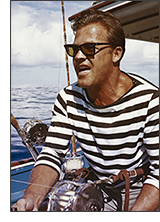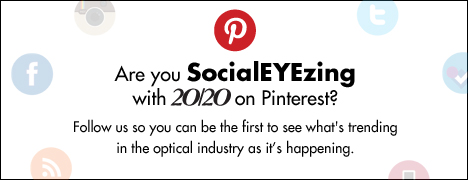|
Your monthly guide to staff training outside the box
Eyes / Lenses / Fitting Lenses / Free-Form / Frames / Sunwear / Patient Solutions / In-office / Standards
SUNWEAR: Filters and Color
COLOR THROUGH SUNGLASSES
Do we see all colors as they actually are? Do we agree on the names of all colors, or see them as the majority of people see them? It’s actually pretty close but color may be slightly different for each of us as a result of what’s received by the cone receptors, illumination, perception and our own personal visual development and age. That makes for slight differences.
For example, as the sun’s intensity changes during the day, color also changes but our eyes adjust pupil size for chromatic consistency so that all colors still look the same. Now add a pair of sunglasses of normal tint, and color is shifted depending on the filter color. The colors seen are skewed, noticeable at first, a surprise for the brain but after a short time, the skewed difference is ignored; however, colors remain shifted. A tinted or polarized lens shifts the white point, altering the tones of any variety of colors, more reddish from brown tints, green or blue shifts from gray-green or gray-blue lenses, etc
—Mark Mattison-Shupnick, ABOM
See Plus »
|
IMPROVING VISION BY ENHANCING EDGES
By Barry Santini, ABOM
After decades of listening to the annual spring sunglass commentators trotting out gray again and again as the “best” sunglass tint, let’s take a close look and see if this old wisdom is really the best consumer advice we can offer.
Sunlight that is filtered by a gray lens leaves the eye’s response curve to color unaltered. Colors retain their natural relationship to each other, and traffic signal recognition remains the same as natural vision—for the “average” person. But in order to enhance our eye’s visual response, we’ll need to emphasize the edge of objects through an alteration of how the eye responds to color.
1. Change overall brightness (stimulus amplitude—changing the overall intensity of the light. 2. Change how we perceive certain colors (changing the stimulus values in selected parts of the spectrum)—we can improve visual recognition of a color-edge border by enhancing the target’s primary color and/or by suppressing the color’s adjoining surround.
By changing the spectral relationship between colors, selectively absorbing some wavelengths more or less than others, sunglass tints can emphasize or suppress the eye’s response to certain wavelengths. This creates a different firing pattern for the cone receptors, and the brain will process this change as edge enhancement. That means different lens filters can be tailored to enhance the visibility for selected activities, such as golf, tennis, clay shooting or even computer usage.
See Plus »
|
|


|
EDUCATE CUSTOMERS
By Michelle Fleischer
The best prevention against UV rays is not just sunglasses in general; it is high quality, premium UV-blocking sunwear. Who says so? The most respected optical organizations across America. It is all over the media as well—even Dr. Oz has promoted sunwear that absorbs UVA and UVB. Want more information about UV, visit The Vision Council website for downloads and material to use to develop your own UV awareness program.

See Plus »
|
AVOID (S)UNFAMILIARITY

Help your customers not only protect their eyes from harmful rays, but also to enjoy comfortable, fatigue-free viewing and improved vision in their chosen leisure or sports activities. Avoid (s)unfamiliarity, which is the tendency to repeat and reinforce the same old tint recommendations year after year. We can start by challenging the “wisdom” of the general media each spring and explain how new technology is providing clear reasons to build a sunglass “wardrobe.” By doing so, you will earn and build client trust and loyalty, which are the building blocks of repeat business and your future success.
See Plus »
|
Visible: Blue Light and Glare
High Energy Visible (HEV) light, i.e., blue light, when accumulated over a lifetime, is of concern because the shortest wavelengths of the visible spectrum contain significant energy. HEV light is powerful enough to injure human cells, mainly through the production of oxygen free radicals. Extended exposure to HEV blue light, like UV radiation, can also cause damage to the eye and the skin around the eye.
Glare from too much visible light always reduces clear and comfortable vision. It can be as simple as the reflections off the back of a sun lens that interrupt clear vision; to a super bright sunny day, to that blinding reflective flash off the dewy wet pavement while driving on a sunny morning. Glare causes squinting, eye fatigue and reduced vision.
A baseball player needs to see accurately when searching for the ball against a blue or overcast sky; a skier must pick out the ice and moguls at speed; and when fly fishing, seeing how the fly just touches the surface of the river may be the difference between fish or steak for dinner. Professional drivers, like mom and dad, need all the visibility they can get with the right pair of sunglasses. Seeing clearly, with the best contrast, can sharpen reaction time.
See Plus »
|
LENSES
Lenses are the other half of sport eyewear protection. Lenses must be polycarbonate for ASTM impact compliance and therefore will also be 100 percent UV-absorbing. For other non-ASTM covered sports, polycarbonate and Trivex material are the material choices. Remember that the child’s eye is more transparent to UV radiation so quality outdoor lenses like photochromics and polarized lenses make a real difference. For more background about UV and children, visit 2020mag.com/ce for the CE “A Focus on Kids’ Eye Health.”
See Plus »
|
Develop a Specialty: Tinted Sportswear Lenses for Individual Sports
Most practices sell sunwear and educate patients on the importance of protecting their eyes from the sun. But many still do not sell a selection of tinted sunwear customized for the particular sports or activities patients participate in. Offering tinted sunwear for sports ranging from golf to hunting is a low-cost way to show patients you care about their unique needs, including finding solutions that suit their individual lifestyle.
Wearing sunglasses on a bright day creates a catch-22 for those who enjoy sports. High-quality sunwear protects the eye from damaging ultra-violet rays, but it makes the pupil larger as the pupil dilates behind the darkened lenses. Vision is defined as the brain’s ability to interpret usable light, so if the sunglasses cut down on the amount of usable light, the athlete’s ability to see the playing field is also reduced. Lenses tinted to suit specific sports offer sun protection that enhances rather than reduces the athlete’s ability to see adequately to play the sport well.
—Donald S. Teig, OD, FAAO
See Plus »
|
|


|
|